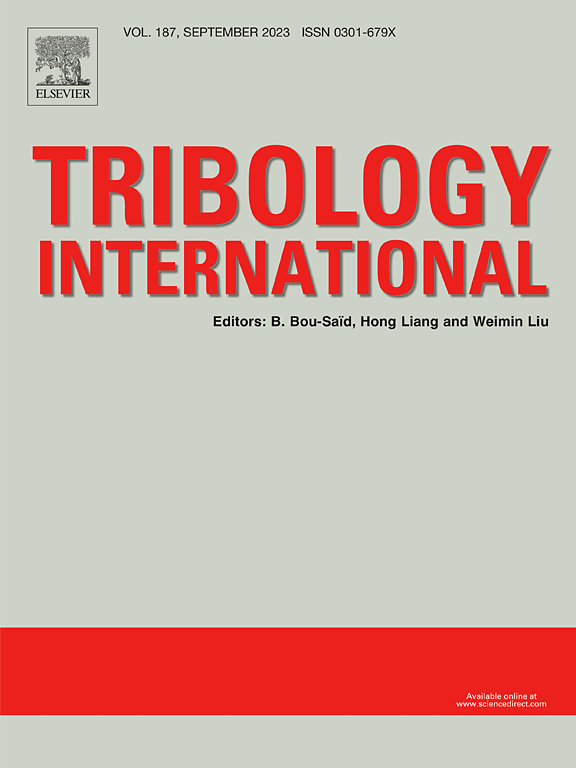Investigations on the material removal and damage formation mechanisms of WC-Co cemented carbide in hybrid laser softening and single-grain scratching processes
IF 6.1
1区 工程技术
Q1 ENGINEERING, MECHANICAL
引用次数: 0
Abstract
Cemented carbide poses significant challenges in precision and damage-free machining due to its extreme hardness and brittleness. This study investigates the material removal mechanisms in Laser-Assisted Machining (LAM) through quasi-static and grinding-type Single-Grain Scratching (SGS) experiments on WC-Co cemented carbide (K10 grade). The effects of Laser Softening Degree (LSD), scratching modes, loads, and strain rates were systematically analyzed, focusing on friction/wear behavior and crack propagation. And the LSD was quantitatively characterized by the Heat-Affected Zone overlap ratio (OHAZ). Results demonstrate that laser softening can effectively reduce the surface friction coefficient (by approximately 40 %) and scratching forces while inhibiting tool wear and surface damage. Acoustic emission signal reveals the formation of brittle chips and radial crack networks during scratching. Furthermore, grinding-type SGS shows a distinct transition from the deformation removal stage to the elastic contact stage. Notably, increasing LSD and scratching speed (4.45 m/s ∼ 40.08 m/s) can both significantly inhibit scratching surface wear and enhance the mechanical response rate of the subsurface microstructure. This work provides fundamental insights into thermal-mechanical coupling in LAM, offering practical guidance for controlling grains’ wear in the precision machining of cemented carbides.
WC-Co硬质合金复合激光软化和单晶粒刻划过程中材料去除及损伤形成机制的研究
硬质合金由于其极高的硬度和脆性,在精密和无损伤加工方面提出了重大挑战。通过对WC-Co硬质合金(K10级)的准静态和磨削型单粒刮擦(SGS)实验,研究了激光辅助加工(LAM)中材料的去除机理。系统分析了激光软化度(LSD)、划痕模式、载荷和应变速率的影响,重点研究了摩擦磨损行为和裂纹扩展。用热影响区重叠比(OHAZ)对LSD进行定量表征。结果表明,激光软化可以有效降低表面摩擦系数(约40% %)和划痕力,同时抑制刀具磨损和表面损伤。声发射信号揭示了划痕过程中脆屑和径向裂纹网络的形成。此外,研磨型SGS表现出从变形去除阶段到弹性接触阶段的明显过渡。值得注意的是,增加LSD和划痕速度(4.45 m/s ~ 40.08 m/s)既能显著抑制划痕表面磨损,又能提高亚表面微观结构的力学响应率。本研究为LAM的热-力耦合提供了基础认识,为硬质合金精密加工中控制晶粒磨损提供了实践指导。
本文章由计算机程序翻译,如有差异,请以英文原文为准。
求助全文
约1分钟内获得全文
求助全文
来源期刊

Tribology International
工程技术-工程:机械
CiteScore
10.10
自引率
16.10%
发文量
627
审稿时长
35 days
期刊介绍:
Tribology is the science of rubbing surfaces and contributes to every facet of our everyday life, from live cell friction to engine lubrication and seismology. As such tribology is truly multidisciplinary and this extraordinary breadth of scientific interest is reflected in the scope of Tribology International.
Tribology International seeks to publish original research papers of the highest scientific quality to provide an archival resource for scientists from all backgrounds. Written contributions are invited reporting experimental and modelling studies both in established areas of tribology and emerging fields. Scientific topics include the physics or chemistry of tribo-surfaces, bio-tribology, surface engineering and materials, contact mechanics, nano-tribology, lubricants and hydrodynamic lubrication.
 求助内容:
求助内容: 应助结果提醒方式:
应助结果提醒方式:


